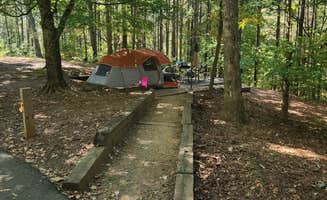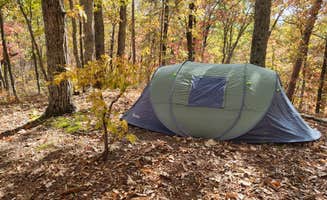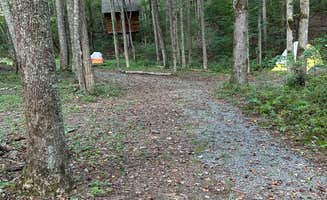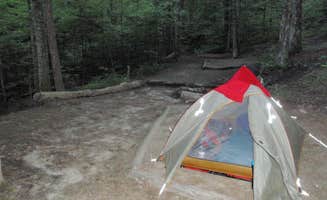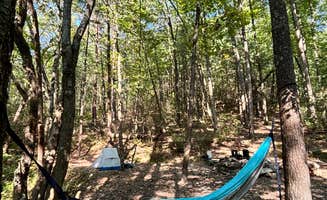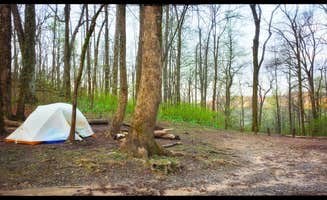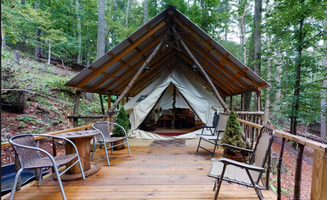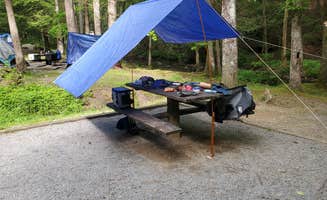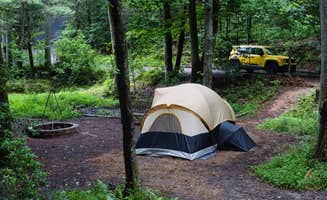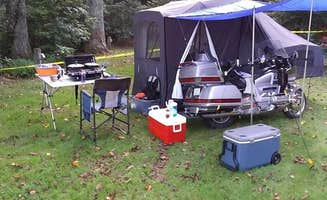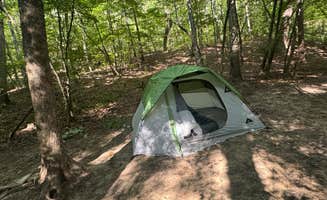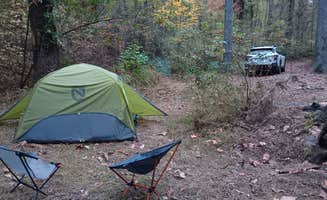Tent camping near Talking Rock, Georgia offers numerous primitive sites nestled within the Chattahoochee National Forest at elevations ranging from 1,800 to 3,700 feet. The area's mixed hardwood forests provide natural shelter while seasonal temperature variations can exceed 30°F between day and night. Water availability fluctuates dramatically between seasons, with spring offering abundant sources that often diminish to trickles by late summer.
What to do
Trout fishing opportunities: The Three Forks area provides access to multiple trout streams where anglers can test their skills. "Three different trout streams come together here and the fishing is fun. There are rules about what kind of lures/hooks you can use, so be sure to do your research," notes a camper at Long Creek Falls Appalachian Trail.
Swimming hole exploration: Many dispersed sites offer natural water features for cooling off during hot months. "Some of the sites and side trails lead to steep drop offs that allow you to scramble around and find some good swimming holes," reports a visitor to Long Creek Falls.
Paddling excursions: The waterways near Talking Rock provide kayaking and canoeing opportunities. A visitor at Ridgeway recommends: "Put in, go right short paddle to Waterfall. Go left into the unknown. Everything's at a 65% slant. $5 to park. Far off the hwy."
Sunset viewing: Some backcountry sites offer spectacular western views. A camper at Fort Mountain State Park Backcountry Campsites shares, "The best part of site #4 is that it's about 0.2 miles from a beautiful west facing overlook where I enjoyed the sunset."
What campers like
Private, secluded sites: Many tent campers appreciate the solitude found at backcountry locations. At Fort Mountain State Park, a camper notes, "The site is private and pretty large. There were plenty of trees for hammocks and a few flat spots for small tents."
Trail proximity: Access to the Appalachian Trail and connecting paths ranks high with visitors. "Lance Creek is a popular stop... After camping here it is an easy hike to get through the active bear area and find safer shelters," explains a hiker at Lance Creek Campsite.
Unexpected amenities: Some primitive sites feature surprising conveniences. A backpacker at Hickory Flatts Cemetery found "an oasis. Trail angels had dropped off two jugs of gatorade, There was a pavilion with picnic benches and a fire ring with a pile of firewood. There was a typical campsite restrooms and it even had a sink."
Natural water access: Proximity to water sources ranks as a key benefit. "There is a water source, just look for trail leading out to left side, about halfway to the pavilion. If you walk upstream, there's a pipe where Spring comes out of ground," explains a caretaker at Hickory Flatts Cemetery.
What you should know
Water reliability varies: Water sources can be unpredictable depending on season. At Springer Mountain Shelter, a camper noted, "Water is nearby (last July it was just a small trickle but still filled our bottles)."
Military training areas: Some forest sections see regular military use. A local cautions about Hickory Flatts: "The Army Rangers use this area of the forest a lot for training."
Limited vehicle access: Many roads leading to camping areas aren't suitable for larger vehicles. A caretaker warns: "If you're pulling a camper, I'd suggest you check out FS251 before you drive into the site, its roughly TWO miles. I'd not bring in a big 5th wheel, etc... and PLEASE don't drive out into the grassy areas, you will get stuck."
Bear safety requirements: Certain sections have specific bear safety regulations. At Lance Creek, a camper notes it's "popular because it is the last place to camp before the bear resistant food container required area."
Tips for camping with families
Short hike options: Some sites offer wilderness experiences with minimal hiking. A visitor to Serenity Ridge mentions, "You don't need camping gear. A tent or two can be set up, ready for you. Cooler stocked with ice. Firewood stacked by the fire pit, ready for you to roast hotdogs or s'mores!"
Kid-friendly tent-only areas: Some locations restrict RVs, creating safer play environments. "I love that this was a tent only camping site (no RVs). The sites were a bit smaller than I would have liked but as it was just the 10 sites on the road, the kids could safely play in the road," reports a parent at Woodring Branch.
Shelter alternatives: For families uncomfortable with tent sleeping, shelter options exist. One camper describes Springer Mountain Shelter as "a three sided, wooden cabin-like structure with a big stone step to get inside. Simple in nature, it's a big open room with a loft where you throw down for the night."
Early arrival importance: Popular sites fill quickly on weekends. A camper advises arriving well before dark to secure preferred spots.
Tips from RVers
Size restrictions: Most dispersed camping areas near Talking Rock have limitations for larger vehicles. Forest service roads often narrow with limited turnaround space.
Primitive setup required: Come prepared for no hookups at most sites. Generators may be prohibited in quieter backcountry areas.
Seasonal closures: Road access can change without notice. A recent visitor to Ridgeway notes: "The campground road access continues to be closed as of July 10, 2024."


